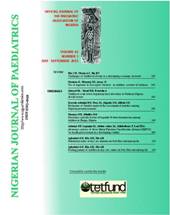
The Nigerian Journal of Paediatrics a quarterly journal publishes original articles, brief reports on clinical and laboratory observations; case reports of substantive value; invited editorial annotations; invited papers on recent electronic clinical briefs, advances, clinical diagnosis, announcements (meetings, courses, job advertisements); summary reports of conferences and book reviews.
Other websites associated with this journal: http://njpaediatrics.com/




